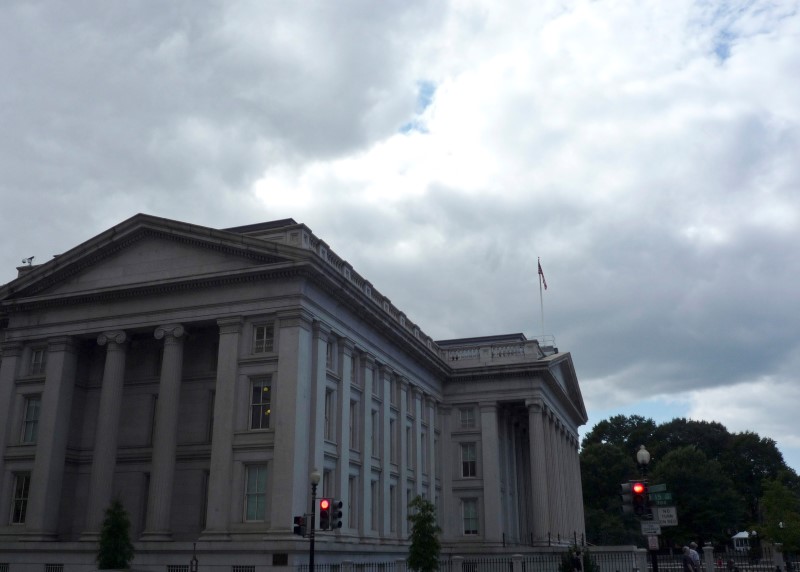 © Reuters. Frenetic Bond Rally Looks Dangerous and Unsustainable
© Reuters. Frenetic Bond Rally Looks Dangerous and Unsustainable(Bloomberg) — BlackRock Inc (NYSE:). is here to remind investors that negative-yielding debt is a potential powder keg for portfolios after a $2.7 trillion surge in the sub-zero stockpile in a matter of days.
Fears about the economic toll of the coronavirus and dovish monetary bets have ramped up the value of bonds guaranteed to impose losses for buy-and-hold managers to $13.9 trillion. From Greece to Austria, investors have been piling into new issues where they are paying to lend.
But with economic data stabilizing, the frenetic bond rally is looking dangerous and unsustainable.
“These assets face a huge task in generating positive returns in 2020,” Rick Rieder, chief investment officer of global fixed income at BlackRock, wrote in a blog post. He sees “negative returns for the negative-yielding universe” as inflation and growth are spurred on by fiscal and monetary support.
BlackRock’s warning chimes with a call from HSBC Holdings Plc (LON:) strategists, who abandoned a buy recommendation on 15-year bunds in favor of French debt, a less obvious haven. At Aberdeen Standard Investments, money manager Luke Hickmore is also a bond bear.
Their peers are in panic-buying mode. Last week alone the value of negative debt surged by the most since Bloomberg began regularly collecting the data three years ago. German bunds returned 2% in January, according to Bank of America (NYSE:) index data, snapping four months of losses.
Orders for Austria’s recent sale of the world’s first syndicated government issue with a sub-zero yield topped 30 billion euros ($33 billion), about 10 times the amount on sale. Days earlier Greece, once a pariah state relying on international bailouts to finance itself, raised Treasury bills at negative yields.
Against the Tide
There may be plenty of doubters, but when it comes to this global bond rally few seem willing to swim against a tide that’s pushed the German yield curve to the flattest since October and inverted a key slice of the U.S. curve last week — a metric that’s often considered a recession signal.
At ING Groep (AS:) NV, rates strategist Antoine Bouvet reckons Germany’s benchmark bund yields will stay negative for at least 18 months, which should coincide with a changeover in government and possibly more acceptance of fiscal stimulus.
“We’re starting 2020 with a lot of liquidity around with major central banks still accommodative and trade risks receding so it’s a bit of a Goldilocks environment,” Bouvet said.
Federal Reserve Chairman Jerome Powell and colleagues kept rates unchanged last week and signaled they would pull out all the stops to avoid a spiral of disinflation. Traders responded by extending a rally that’s trimmed 26 basis points off benchmark Treasury yields in the past month. That followed ECB President Christine Lagarde saying policy must remain “highly accommodative” with inflation struggling to stay much above 1%.
“Buy negative-yielding bonds? Absolutely,” said Bouvet. “A lot of investors get money at even more negative rates than where they invest them so they can still make money. There’s still scope for European government bond yields to move even more negative.”
Meanwhile, the haven nature of recent demand also means many investors will be looking past price risk, accepting it as necessary to hedge their portfolios and park cash in safer securities.
‘Pop’ Higher
Back at BlackRock, Rieder reckons even if the turmoil surrounding the coronavirus drives global government bonds yields “temporarily lower,” benchmark Treasury yields will eventually rise about 30 basis points from current levels to “hover in a range around 1.8%.” That would match the Fed policy rate, stabilizing growth and inflation, he argues.
BlackRock says investors can earn 5% returns this year by barbelling high-quality bonds against riskier equity and alternative assets.
History is arguably on the side of Rieder. Negative yields guarantee losses if held to maturity, and new investment-grade issues of bonds with sub-zero yields sold last year ended 2019 in the red. They lost investors 0.46%, compared with a gain of 1.41% for bonds issued with a positive yield, according to data compiled by Bloomberg.
“I think when this clears up we will see global yields pop higher,” said Hickmore at Aberdeen.



